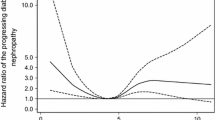Abstract
Background
Hyperuricemia is a risk factor for end-stage renal disease. This study examined the association between serum uric acid and renal damage in a community-based population.
Methods
In this study 3126 subjects without renal insufficiency were recruited at baseline and were followed for one year. The urinary albumin–creatinine ratio (UACR) and β2-microglobulin–creatinine ratio (UBCR) in morning spot urine samples were used as indices of either glomerular (UACR) or tubular (UBCR) damage.
Results
The mean value of serum uric acid (mg/dL) was 5.8 ± 1.3 (SD) in men and 4.5 ± 1.1 in women. In cross-sectional analysis the increased serum uric acid levels were accompanied by higher UACR values in both men and women (P < 0.01). In contrast, UBCR values were reduced when uric acid levels increased in both men and women (P < 0.01). Multivariate analysis revealed that albuminuria (UACR ≥ 30 mg/g) was significantly associated with increased uric acid (≥7 mg/dL for men, ≥6 mg/dL for women). High UBCR (≥300 μg/g) was negatively associated with uric acid in men, but not in women, after adjustment for possible confounders. In longitudinal analysis in 1388 subjects multiple linear regression analysis showed that uric acid at baseline was an independent factor for one-year increase of UACR [coefficient 4.80 (95 % confidence interval 0.40–9.33) (mg/g) per 1 mg/dL increase in uric acid, P = 0.033].
Conclusion
This study showed that serum uric acid concentration was positively associated with UACR, suggesting that uric acid may be related to glomerular damage in a community-based population.





Similar content being viewed by others
References
Go AS, Chertow GM, Fan D, McCulloch CE, Hsu CY. Chronic kidney disease and the risks of death, cardiovascular events, and hospitalization. N Engl J Med. 2004;351:1296–305.
Fang J, Alderman MH. Serum uric acid and cardiovascular mortality the NHANES I epidemiologic follow-up study, 1971–1992. National Health and Nutrition Examination Survey. JAMA. 2000;283:2404–10.
Chen JH, Chuang SY, Chen HJ, Yeh WT, Pan WH. Serum uric acid level as an independent risk factor for all-cause, cardiovascular, and ischemic stroke mortality: a Chinese cohort study. Arthr Rheum. 2009;61:225–32.
Iseki K, Oshiro S, Tozawa M, Iseki C, Ikemiya Y, Takishita S. Significance of hyperuricemia on the early detection of renal failure in a cohort of screened subjects. Hypertens Res. 2001;24:691–7.
Konta T, Hao Z, Abiko H, Ishikawa M, Takahashi T, Ikeda A, et al. Prevalence and risk factor analysis of microalbuminuria in Japanese general population: the Takahata study. Kidney Int. 2006;70:751–6.
World Health Organization, International Association for the Study of Obesity, International Obesity Taskforce. The Asia-Pacific perspective: redefining obesity and its treatment. Sydney:Health Communications Australia Pty Limited; 2000. p. 15–21.
Kudo K, Konta T, Mashima Y, Ichikawa K, Takasaki S, Ikeda A, et al. The association between renal tubular damage and rapid renal deterioration in the Japanese population: the Takahata study. Clin Exp Nephrol. 2011;15:2352–441.
Matsuo S, Imai E, Horio M, Yasuda Y, Tomita K, Nitta K, et al. Revised equations for estimated GFR from serum creatinine in Japan. Am J Kidney Dis. 2009;53:982–92.
Kawasaki T, Itoh K, Uezono K, Sasaki H. A simple method for estimating 24-h urinary sodium and potassium excretion from second morning voiding urine specimen in adults. Clin Exp Pharmacol Physiol. 1993;20:7–14.
Iseki K, Oshiro S, Tozawa M, Iseki C, Ikemiya Y, Takishita S. Significance of hyperuricemia on the early detection of renal failure in a cohort of screened subjects. Hypertens Res. 2001;24:691–7.
Siu YP, Leung KT, Tong MK, Kwan TH. Use of allopurinol in slowing the progression of renal disease through its ability to lower serum uric acid level. Am J Kidney Dis. 2006;47:51–9.
Ward HJ. Uric acid as an independent risk factor in the treatment of hypertension. Lancet. 1998;352:670–1.
Zhang W, Sun K, Yang Y, Zhang H, Hu FB, Hui R. Plasma uric acid and hypertension in a Chinese community: prospective study and meta-analysis. Clin Chem. 2009;55:2026–34.
Price KL, Sautin YY, Long DA, Zhang L, Miyazaki H, Mu W, et al. Human vascular smooth muscle cells express a urate transporter. J Am Soc Nephrol. 2006;17:1791–5.
Johnson RJ, Kang DH, Feig D, Kivlighn S, Kanellis J, Watanabe S, et al. Is there a pathogenetic role for uric acid in hypertension and cardiovascular and renal disease? Hypertension. 2003;41:1183–90.
Kang DH, Park SK, Lee IK, Johnson RJ. Uric acid-induced C-reactive protein expression: implication on cell proliferation and nitric oxide production of human vascular cells. J Am Soc Nephrol. 2005;16:3553–62.
Mazzali M, Kanellis J, Han L, Feng L, Xia YY, Chen Q, et al. Hyperuricemia induces a primary renal arteriolopathy in rats by a blood pressure-independent mechanism. Am J Physiol Renal Physiol. 2002;282:F991–7.
Sánchez-Lozada LG, Tapia E, Santamaría J, Avila-Casado C, Soto V, Nepomuceno T, et al. Mild hyperuricemia induces vasoconstriction and maintains glomerular hypertension in normal and remnant kidney rats. Kidney Int. 2005;67:237–47.
Høieggen A, Alderman MH, Kjeldsen SE, Julius S, Devereux RB, De Faire U, et al. The impact of serum uric acid on cardiovascular outcomes in the LIFE study. Kidney Int. 2004;65:1041–9.
Acknowledgments
This study was supported in part by the 21st Century Center of Excellence (COE) Program and the global COE of the Japan Society for the Promotion of Science.
Conflict of interest
None.
Author information
Authors and Affiliations
Corresponding author
About this article
Cite this article
Suzuki, K., Konta, T., Kudo, K. et al. The association between serum uric acid and renal damage in a community-based population: the Takahata study. Clin Exp Nephrol 17, 541–548 (2013). https://doi.org/10.1007/s10157-012-0743-y
Received:
Accepted:
Published:
Issue Date:
DOI: https://doi.org/10.1007/s10157-012-0743-y




